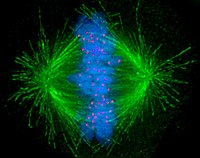
Photo from wikipedia
The nanoscale protein architecture of the kinetochore plays an integral role in specifying the mechanisms underlying its functions in chromosome segregation. However, defining this architecture in human cells remains challenging… Click to show full abstract
The nanoscale protein architecture of the kinetochore plays an integral role in specifying the mechanisms underlying its functions in chromosome segregation. However, defining this architecture in human cells remains challenging because of the large size and compositional complexity of the kinetochore. Here, we use Förster resonance energy transfer to reveal the architecture of individual kinetochore-microtubule attachments in human cells. We find that the microtubule-binding domains of the Ndc80 complex cluster at the microtubule plus end. This clustering occurs only after microtubule attachment, and it increases proportionally with centromeric tension. Surprisingly, Ndc80 complex clustering is independent of the organization and number of its centromeric receptors. Moreover, this clustering is similar in yeast and human kinetochores despite significant differences in their centromeric organizations. These and other data suggest that the microtubule-binding interface of the human kinetochore behaves like a flexible "lawn" despite being nucleated by repeating biochemical subunits.
Journal Title: Current Biology
Year Published: 2020
Link to full text (if available)
Share on Social Media: Sign Up to like & get
recommendations!